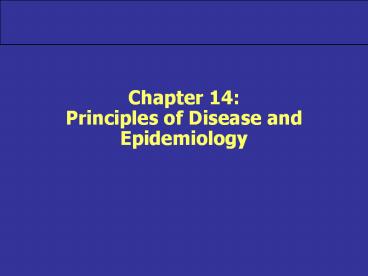Chapter 14: Principles of Disease and Epidemiology - PowerPoint PPT Presentation
1 / 20
Title:
Chapter 14: Principles of Disease and Epidemiology
Description:
Chapter 14: Principles of Disease and Epidemiology Principles of Disease and Epidemiology Pathology Study of disease Etiology Cause of a disease Pathogenesis ... – PowerPoint PPT presentation
Number of Views:500
Avg rating:3.0/5.0
Title: Chapter 14: Principles of Disease and Epidemiology
1
Chapter 14Principles of Disease and Epidemiology
2
Principles of Disease and Epidemiology
- Pathology Study of disease
- Etiology Cause of a disease
- Pathogenesis Development of disease
- Infectious disease Caused by microorganisms
3
Normal Microbiota and the Host
- Locations of normal microbiota on and in the
human body
Figure 14.2
4
Normal Microbiota and the Host
- Normal microbiota permanently colonize the host
- Prevent growth of harmful microbes
- Microbial antagonism competition among microbes
- Compete for nutrients, space
- Affect pH, oxygen availability
- Some produce bacteriocins (antibiotic proteins)
- Some normal microbiota are opportunistic
pathogens - Cause disease only in abnormal environments/
circumstances
5
Normal Microbiota and the HostSymbiosis
Symbiosis Relationship between normal microbiota
and host
Commensalism One organism benefits, and the
other is unaffected
Parasitism One organism benefits at the expense
of the other
Mutualism Both organisms benefit
Opportunistic pathogens
Normal microbiota
6
Normal Microbiota and the HostOpportunistic
Pathogens
- Antibiotic-associated diarrhea (AAD)
- Clostridium difficile
- Release of toxins leads to colon inflammation
- Also nonpathogenic strains
- One of the most common nosocomial infections
around the world - 20 of US hospitalized patients acquire C.
difficile - Result of normal intestinal microbiota
disturbance by antibiotics - Can progress to more serious conditions (severe
colitis)
www.textbookofbacteriology.net
7
Kochs PostulatesDetermining infectious disease
etiology
Application of Kochs Postulates
- Koch's Postulates
- Set of requirements that must be met to prove
that a specific microbe causes a specific
disease - Framework for studying infectious disease
etiology - B. anthracis causes anthrax
Isolation
Pure culture Identification
Inoculation
Figure 14.3.1
8
Kochs PostulatesDetermining infectious disease
etiology
Disease reproduction
Original microbe re-isolation
Figure 14.3.2
9
Stages of Disease Development
Overt signs and symptoms
Infection can be spread
Figure 14.5
10
The Spread of InfectionReservoirs of Infection
- Reservoirs of infection sources of disease
organisms - Humans AIDS, gonorrhea
- Carriers may have inapparent infections or latent
diseases (incubation or convalescence periods) - Animals Rabies, Lyme disease
- Some zoonoses may be transmitted to humans
- Nonliving Botulism, tetanus
- Soil, water, foods
11
The Spread of InfectionRoutes of Disease
Transmission
- Contact transmission
- Vehicle transmission
- Vector transmission
12
The Spread of InfectionRoutes of Disease
Transmission
- Contact transmission spread of pathogen by
- Direct contact (person-to-person)
- Touching, kissing, sexual intercourse
- Indirect contact (via fomites)
- Fomites nonliving objects involved in the spread
of infection (bedding, eating utensils,
thermometers) - Droplet transmission
- Sneezes, coughs
- Up to 20,000 droplets per sneeze!
13
The Spread of InfectionRoutes of Disease
Transmission
- Vehicle transmission transmission by an
inanimate reservoir (food, water, air) - Vector transmission Animals transmit pathogens
- Often arthropods (fleas, ticks, mosquitoes)
- Arthropods can carry pathogens on their feet
14
Nosocomial (Hospital-Acquired) Infections
- Nosocomial infections acquired as a result of a
hospital stay - 5-15 of all hospital patients acquire nosocomial
infections - Eighth leading cause of death in U.S. (20,000/yr)
Percentage of nosocomial infections
Gram cocci (S. aureus, etc.) 34
Gram rods 32
Clostridium difficile 17
Fungi 10
15
Common Causes of Nosocomial Infections
- Factors affecting nosocomial infection
acquisition - Presence of microorganisms in hospital
- Compromised health/immune status of the host
- Effective chain of transmission
Broken skin/mucous membranes, immunosuppression
Person-to-person, fomites, ventilation system,
etc.
Figure 14. 9
- CDC Handwashing is the single most important
method of preventing the spread of infection
16
Epidemiology
- Epidemiology the study of where and when
diseases occur - Identify the source and mode of transmission of a
disease - Extensive population data collection and
statistical analyses - Centers for Disease Control and Prevention (CDC)
- Collects and analyzes epidemiological information
in the U.S. - Notifiable diseases physicians are required by
law to report cases to the US Public Health
Service
17
Table 14.7
18
(No Transcript)
19
Outbreak 34 cases of C. tropicalis candiduria in
5 months in SICU
Outbreak (patient) isolates
Non-outbreak (unrelated) isolates
76 environmental swab samples
6 C. tropicalis isolates, all along urine
disposal route
All six matched DNA fingerprint of patient
isolates
Reservoirs of infection identified improperly
disinfected urinals, urine collection bucket, med
waste disposal sink
20
(No Transcript)

